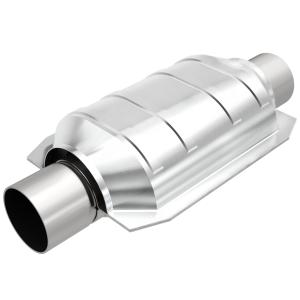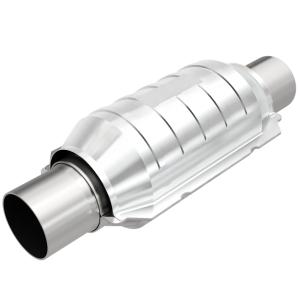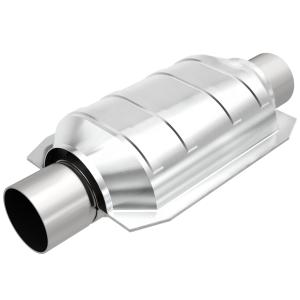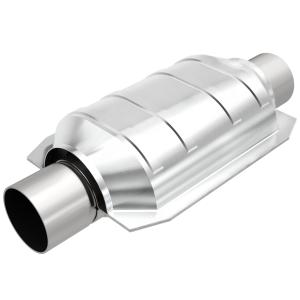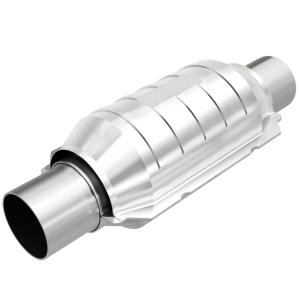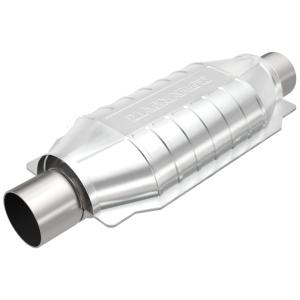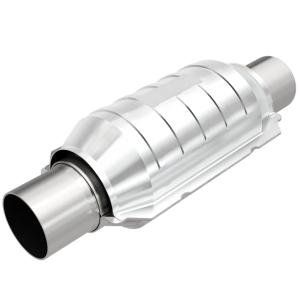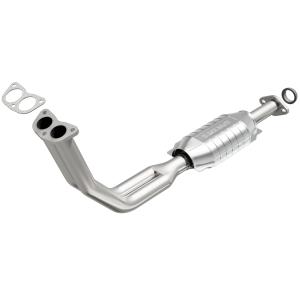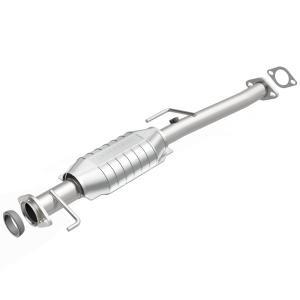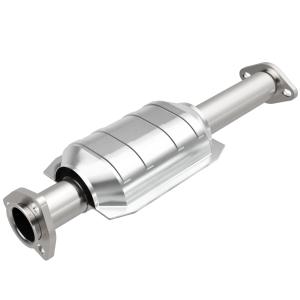Hello, Sign In!
Suzuki Sidekick Catalytic Converters
At Andy's Auto Sport, we have a huge variety of Suzuki Sidekick catalytic converters to ensure that you have every catalytic converter option available to you. We go out of our way to carry every major line of Suzuki Sidekick catalytic converters, so that whether you are looking for replacement Suzuki Sidekick catalytic converter or a performance high flow cat or anything in between, we've got it for you. Andy's Auto Sport is the ultimate shopping destination for your Suzuki Sidekick catalytic converter needs!
Select Your Vehicle
Shop Suzuki Sidekick Catalytic Converters by Brand
1 - 10 of 10
Sort by:

Fits: 1990 Suzuki Sidekick; 1.6, 4L, 1992 Suzuki Sidekick; 1.6, 4L, 1995 Suzuki Sidekick; 1.6, 4L, 1994 Suzuki Sidekick; 1.6, 4L, 1993 Suzuki Sidekick; 1.6,...
PART# 91003

Fits: 1997 Toyota Tercel, 1999 Toyota Tacoma, 1997 Suzuki-90, 1996 Toyota Tacoma, 1997 Toyota Celica, 1995 Toyota Paseo, 1998 Toyota Tercel, 1996 Toyota Cel...
PART# 408004

Fits: 1992 Suzuki Sidekick; 1.6, 4L, 1991 Toyota MR2; 2, 4L, 1991 Suzuki Samurai; 1.3, 4L, 1993 Toyota Pickup; 3, 6V, 1994 Toyota MR2; 2, 4L, 1990 Suzuki Sa...
PART# 91004

Fits: 1989 Toyota Supra; 3, 6L, 1987 Toyota Supra; 3, 6L, 1994 Toyota Previa DX;2.4, 4L, 1990 Toyota Celica; 2, 4L, 1989 Toyota Camry; 2.5, 6V, 1981 Toyota ...
PART# 91005

Fits: 1999 Toyota Tacoma, 1997 Suzuki-90, 1997 Toyota Celica, 1996 Toyota Tacoma, 1998 Volvo V70, 1998 Suzuki Sidekick, 1997 Suzuki Sidekick, 1996 Suzuki Si...
PART# 408005

Fits: 2001 Toyota Camry; 3, 6V, 2000 Toyota Tacoma; 2.7, 4L, 1990 Toyota Celica; 2, 4L, 1999 Toyota Solara; 3, 6V, 1998 Toyota Camry; 2.2, 4L, 2003 Suzuki V...
PART# 99005HM

Fits: 1998 Volvo V70, 1998 Suzuki Sidekick, 1995 Volvo 850, 1999 Toyota Tacoma, 1997 Suzuki Sidekick, 1996 Suzuki Sidekick, 1997 Suzuki-90, 1997 Volvo 850, ...
PART# 408006

Fits: 1990 Suzuki Sidekick; 1.6, 4L, 1992 Suzuki Sidekick; 1.6, 4L, 1995 Suzuki Sidekick; 1.6, 4L, 1994 Suzuki Sidekick; 1.6, 4L, 1993 Suzuki Sidekick; 1.6,...
PART# 22618

Fits: 1997 Suzuki Sidekick; 1.6, 4L, 1998 Suzuki-90; 1.6, 4L, 1996 Suzuki-90; 1.6, 4L, 1998 Suzuki Sidekick; 1.6, 4L, 1996 Suzuki Sidekick; 1.6, 4L, 1995 Su...
PART# 22626

Fits: 1992 Suzuki Sidekick; 1.6, 4L, 1991 Suzuki Sidekick; 1.6, 4L
PART# 22619
| Previous | 1 | Next |
When you click on links to various merchants on this site and make a purchase, this can result in this site earning a commission. Affiliate programs and affiliations include, but are not limited to, the eBay Partner Network.
Not able to find what you are looking for?


Catalytic Converter Fits: 1996 1997 1998 Suzuki Sidekick

EPA Catalytic Converter Fits: 1989 Suzuki Sidekick 1.6L L4 GAS SOHC

EPA Catalytic Converter Fits: 1993 1994 1995 Suzuki Sidekick

Fits > Chevy/Suzuki-Front Pipe 89-98 Tracker / Sidekick 1.6L catalytic converter

Catalytic Converter Fits: 1990-1993 Suzuki Sidekick

MagnaFlow 22618-BC Fits 1993 1994 1995 Suzuki Sidekick Catalytic Converter
WHY TO BUY?
The good news is that, although replacement Suzuki Sidekick catalytic converters can be costly from your local dealership, aftermarket units (many times made by the same original equipment manufacturers) are substantially less expensive and can be purchased as direct-fit bolt-on units (assuming that the original converter was also bolted on) or weld-on units. Replacing your Suzuki Sidekick catalytic converter can restore power that has been lost due to a faulty original converter and will make your vehicle run better overall. In addition, a bad Suzuki Sidekick catalytic converter means that your exhaust is releasing harmful toxins into the atmosphere and environment, so getting a new one means you’re doing your part to keep the earth and its atmosphere clean.
DID YOU KNOW?
Modern catalytic converters are much less restrictive than in days past, so much so that the antiquated (and illegal) method of "gutting" the converters of their internal structures has been deemed almost pointless on newer cars, as the performance gains are minimal, if any. Aftermarket high-flow Suzuki Sidekick catalytic converters are therefore a much better (and more responsible) choice for those seeking to upgrade their exhaust systems or replace a faulty converter.
So how do you know if your Suzuki Sidekick catalytic converter is on its way out? If your Suzuki Sidekick engine seems to be losing power or your temperature gauge reads a little high, one possible culprit could be that a rich condition is feeding excessive unburned fuel into the catalytic converter, which can overheat it as well as damage it. It is common to see your Suzuki Sidekick catalytic converter glowing orange/red when this condition is present. Another common sign of catalytic converter failure is the infamous "rotten egg" smell. Other common symptoms include: a lack of power, rough engine idle, or stalling. If you are replacing your Suzuki Sidekick catalytic converter due to any of the above circumstances, it is a good idea to also replace your oxygen sensor, since it plays a vital role in the air/fuel mixture ratio and may have also been damaged due to the same adverse conditions. Finally, physical damage can sometimes occur if a large rock or other object hits Suzuki Sidekick catalytic converter, resulting in a damaged ceramic core. This can often be heard, as smaller ceramic pieces will bounce around inside the converter housing. As you can imagine, this is often accompanied by a loss of power due to exhaust blockage.
So how do you know if your Suzuki Sidekick catalytic converter is on its way out? If your Suzuki Sidekick engine seems to be losing power or your temperature gauge reads a little high, one possible culprit could be that a rich condition is feeding excessive unburned fuel into the catalytic converter, which can overheat it as well as damage it. It is common to see your Suzuki Sidekick catalytic converter glowing orange/red when this condition is present. Another common sign of catalytic converter failure is the infamous "rotten egg" smell. Other common symptoms include: a lack of power, rough engine idle, or stalling. If you are replacing your Suzuki Sidekick catalytic converter due to any of the above circumstances, it is a good idea to also replace your oxygen sensor, since it plays a vital role in the air/fuel mixture ratio and may have also been damaged due to the same adverse conditions. Finally, physical damage can sometimes occur if a large rock or other object hits Suzuki Sidekick catalytic converter, resulting in a damaged ceramic core. This can often be heard, as smaller ceramic pieces will bounce around inside the converter housing. As you can imagine, this is often accompanied by a loss of power due to exhaust blockage.
FAQs
Q: What is a hi-flow catalytic converter? Why buy one?
A: All stock catalytic converters are restrictive when it comes to exhaust flow, and they essentially place a choke hold on performance. The hi-flow catalytic converters on the market today have a higher flow capacity than factory units. Still able to pass emissions and gain horsepower, how can you go wrong with a hi-flow catalytic converter?
Q: How do you install a hi-flow catalytic converter?
A: There are two kinds of catalytic converters. The first are direct fit converters (no welding required) which have all necessary flanges and oxygen sensors just like the original equipment catalytic converters. There are also universal fit catalytic converters that are designed to be welded or clamped in place. Universal fit converters have the same flow characteristics as direct fit models with the same inlet and outlet diameter.
A: All stock catalytic converters are restrictive when it comes to exhaust flow, and they essentially place a choke hold on performance. The hi-flow catalytic converters on the market today have a higher flow capacity than factory units. Still able to pass emissions and gain horsepower, how can you go wrong with a hi-flow catalytic converter?
Q: How do you install a hi-flow catalytic converter?
A: There are two kinds of catalytic converters. The first are direct fit converters (no welding required) which have all necessary flanges and oxygen sensors just like the original equipment catalytic converters. There are also universal fit catalytic converters that are designed to be welded or clamped in place. Universal fit converters have the same flow characteristics as direct fit models with the same inlet and outlet diameter.
Filter Your Results
Category 

-
Catalytic Converters(10)
Brand 

-
 MagnaFlow(10)
MagnaFlow(10)
Suzuki Sidekick Catalytic Converters
At Andy's Auto Sport, we have a huge variety of Suzuki Sidekick catalytic converters to ensure that you have every catalytic converter option available to you. We go out of our way to carry every major line of Suzuki Sidekick catalytic converters, so that whether you are looking for replacement Suzuki Sidekick catalytic converter or a performance high flow cat or anything in between, we've got it for you. Andy's Auto Sport is the ultimate shopping destination for your Suzuki Sidekick catalytic converter needs!
Choose Your Vehicle:
Shop Suzuki Sidekick Catalytic Converters by Brand
1 - 10 of 10
Sort by:

Fits: 1990 Suzuki Sidekick; 1.6, 4L, 1992 Suzuki Sidekick; 1.6, 4L, 1995 Suzuki Sidekick; 1.6, 4L, 1994 Suzuki Sidekick; 1.6, 4L, 1993 Suzuki Sidekick; 1.6,...
PART# 91003

Fits: 1997 Toyota Tercel, 1999 Toyota Tacoma, 1997 Suzuki-90, 1996 Toyota Tacoma, 1997 Toyota Celica, 1995 Toyota Paseo, 1998 Toyota Tercel, 1996 Toyota Cel...
PART# 408004

Fits: 1992 Suzuki Sidekick; 1.6, 4L, 1991 Toyota MR2; 2, 4L, 1991 Suzuki Samurai; 1.3, 4L, 1993 Toyota Pickup; 3, 6V, 1994 Toyota MR2; 2, 4L, 1990 Suzuki Sa...
PART# 91004

Fits: 1989 Toyota Supra; 3, 6L, 1987 Toyota Supra; 3, 6L, 1994 Toyota Previa DX;2.4, 4L, 1990 Toyota Celica; 2, 4L, 1989 Toyota Camry; 2.5, 6V, 1981 Toyota ...
PART# 91005

Fits: 1999 Toyota Tacoma, 1997 Suzuki-90, 1997 Toyota Celica, 1996 Toyota Tacoma, 1998 Volvo V70, 1998 Suzuki Sidekick, 1997 Suzuki Sidekick, 1996 Suzuki Si...
PART# 408005

Fits: 2001 Toyota Camry; 3, 6V, 2000 Toyota Tacoma; 2.7, 4L, 1990 Toyota Celica; 2, 4L, 1999 Toyota Solara; 3, 6V, 1998 Toyota Camry; 2.2, 4L, 2003 Suzuki V...
PART# 99005HM

Fits: 1998 Volvo V70, 1998 Suzuki Sidekick, 1995 Volvo 850, 1999 Toyota Tacoma, 1997 Suzuki Sidekick, 1996 Suzuki Sidekick, 1997 Suzuki-90, 1997 Volvo 850, ...
PART# 408006

Fits: 1990 Suzuki Sidekick; 1.6, 4L, 1992 Suzuki Sidekick; 1.6, 4L, 1995 Suzuki Sidekick; 1.6, 4L, 1994 Suzuki Sidekick; 1.6, 4L, 1993 Suzuki Sidekick; 1.6,...
PART# 22618

Fits: 1997 Suzuki Sidekick; 1.6, 4L, 1998 Suzuki-90; 1.6, 4L, 1996 Suzuki-90; 1.6, 4L, 1998 Suzuki Sidekick; 1.6, 4L, 1996 Suzuki Sidekick; 1.6, 4L, 1995 Su...
PART# 22626

Fits: 1992 Suzuki Sidekick; 1.6, 4L, 1991 Suzuki Sidekick; 1.6, 4L
PART# 22619
| Previous | 1 | Next |
When you click on links to various merchants on this site and make a purchase, this can result in this site earning a commission. Affiliate programs and affiliations include, but are not limited to, the eBay Partner Network.
Not able to find what you are looking for?


Catalytic Converter Fits: 1996 1997 1998 Suzuki Sidekick

EPA Catalytic Converter Fits: 1989 Suzuki Sidekick 1.6L L4 GAS SOHC

EPA Catalytic Converter Fits: 1993 1994 1995 Suzuki Sidekick

Fits > Chevy/Suzuki-Front Pipe 89-98 Tracker / Sidekick 1.6L catalytic converter

Catalytic Converter Fits: 1990-1993 Suzuki Sidekick

MagnaFlow 22618-BC Fits 1993 1994 1995 Suzuki Sidekick Catalytic Converter
WHY TO BUY?
The good news is that, although replacement Suzuki Sidekick catalytic converters can be costly from your local dealership, aftermarket units (many times made by the same original equipment manufacturers) are substantially less expensive and can be purchased as direct-fit bolt-on units (assuming that the original converter was also bolted on) or weld-on units. Replacing your Suzuki Sidekick catalytic converter can restore power that has been lost due to a faulty original converter and will make your vehicle run better overall. In addition, a bad Suzuki Sidekick catalytic converter means that your exhaust is releasing harmful toxins into the atmosphere and environment, so getting a new one means you’re doing your part to keep the earth and its atmosphere clean.
DID YOU KNOW?
Modern catalytic converters are much less restrictive than in days past, so much so that the antiquated (and illegal) method of "gutting" the converters of their internal structures has been deemed almost pointless on newer cars, as the performance gains are minimal, if any. Aftermarket high-flow Suzuki Sidekick catalytic converters are therefore a much better (and more responsible) choice for those seeking to upgrade their exhaust systems or replace a faulty converter.
So how do you know if your Suzuki Sidekick catalytic converter is on its way out? If your Suzuki Sidekick engine seems to be losing power or your temperature gauge reads a little high, one possible culprit could be that a rich condition is feeding excessive unburned fuel into the catalytic converter, which can overheat it as well as damage it. It is common to see your Suzuki Sidekick catalytic converter glowing orange/red when this condition is present. Another common sign of catalytic converter failure is the infamous "rotten egg" smell. Other common symptoms include: a lack of power, rough engine idle, or stalling. If you are replacing your Suzuki Sidekick catalytic converter due to any of the above circumstances, it is a good idea to also replace your oxygen sensor, since it plays a vital role in the air/fuel mixture ratio and may have also been damaged due to the same adverse conditions. Finally, physical damage can sometimes occur if a large rock or other object hits Suzuki Sidekick catalytic converter, resulting in a damaged ceramic core. This can often be heard, as smaller ceramic pieces will bounce around inside the converter housing. As you can imagine, this is often accompanied by a loss of power due to exhaust blockage.
So how do you know if your Suzuki Sidekick catalytic converter is on its way out? If your Suzuki Sidekick engine seems to be losing power or your temperature gauge reads a little high, one possible culprit could be that a rich condition is feeding excessive unburned fuel into the catalytic converter, which can overheat it as well as damage it. It is common to see your Suzuki Sidekick catalytic converter glowing orange/red when this condition is present. Another common sign of catalytic converter failure is the infamous "rotten egg" smell. Other common symptoms include: a lack of power, rough engine idle, or stalling. If you are replacing your Suzuki Sidekick catalytic converter due to any of the above circumstances, it is a good idea to also replace your oxygen sensor, since it plays a vital role in the air/fuel mixture ratio and may have also been damaged due to the same adverse conditions. Finally, physical damage can sometimes occur if a large rock or other object hits Suzuki Sidekick catalytic converter, resulting in a damaged ceramic core. This can often be heard, as smaller ceramic pieces will bounce around inside the converter housing. As you can imagine, this is often accompanied by a loss of power due to exhaust blockage.
FAQs
Q: What is a hi-flow catalytic converter? Why buy one?
A: All stock catalytic converters are restrictive when it comes to exhaust flow, and they essentially place a choke hold on performance. The hi-flow catalytic converters on the market today have a higher flow capacity than factory units. Still able to pass emissions and gain horsepower, how can you go wrong with a hi-flow catalytic converter?
Q: How do you install a hi-flow catalytic converter?
A: There are two kinds of catalytic converters. The first are direct fit converters (no welding required) which have all necessary flanges and oxygen sensors just like the original equipment catalytic converters. There are also universal fit catalytic converters that are designed to be welded or clamped in place. Universal fit converters have the same flow characteristics as direct fit models with the same inlet and outlet diameter.
A: All stock catalytic converters are restrictive when it comes to exhaust flow, and they essentially place a choke hold on performance. The hi-flow catalytic converters on the market today have a higher flow capacity than factory units. Still able to pass emissions and gain horsepower, how can you go wrong with a hi-flow catalytic converter?
Q: How do you install a hi-flow catalytic converter?
A: There are two kinds of catalytic converters. The first are direct fit converters (no welding required) which have all necessary flanges and oxygen sensors just like the original equipment catalytic converters. There are also universal fit catalytic converters that are designed to be welded or clamped in place. Universal fit converters have the same flow characteristics as direct fit models with the same inlet and outlet diameter.
VIDEOS RELATED TO SUZUKI SIDEKICK CATALYTIC CONVERTERS
VIDEOS RELATED TO SUZUKI SIDEKICK CATALYTIC CONVERTERS
-
Video Description:Catalytic Converters on Andy's Auto Sport TV!
This is an Andy's Auto Sport TV episode where we break down the basics of catalytic converters. We explain the difference between a direct-fit bolt-on catalytic converter and a universal weld-on catalytic converter. We also go over the benefits of getting a new cat, and we even do an installation to show what's involved.


